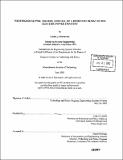Westinghouse PWR : the rise and fall of a dominant design in the electric power industry
Author(s)
Barrientos, Carlos J. (Carlos Jose), 1966-
DownloadFull printable version (25.85Mb)
Alternative title
Westinghouse Pressurized Water Reactor : the rise and fall of a dominant design in the electric power industry
Other Contributors
Massachusetts Institute of Technology. Technology and Policy Program.
Advisor
John S. Carroll.
Terms of use
Metadata
Show full item recordAbstract
In the early 1950s the electric power industry was shaken by the introduction of a new type of energy source that pledged to be the most cost-efficient way of producing electricity. Counting on the promise of huge profits -attributed to large economies of scale- governments and utilities rushed to develop and construct nuclear power plants. From 1952 to 1985, four hundred units were built all across the industrialized world, from the United States to the Soviet Union and from Sweden to Taiwan. Nuclear power accounted for the most impressive capacity build-up in 100 years of electricity history. As was the case with most of the strategic technologies developed in the 20th century, the first nuclear prototypes were developed in the United States, with the sponsorship of the federal government. The funding ended up mainly in R&D expenditures administered by the Atomic Energy Commission (AEC). As a result of such a strong commitment to nuclear, the United States quickly became the technological leader in the world. Such leadership meant not only building most of the nuclear power plants in its territory -125 out of 480- but establishing industry standards in many areas: from design, licensing and construction to commercial operation, and decommissioning. This research explores one of the most substantial legacies of the U.S. nuclear power undertaking: the PWR reactor developed by Westinghouse. The research examines the story of the PWR from its origins in the drawing rooms of the Bettis Laboratories in the 1950s to its rapid adoption in the 1960s as the dominant design in the industry. The main goal of the research is describing the dynamics of the process, building at the same time a workable framework of analysis. The first part of the research digs down into plants' data. Using a large database of reactors' records, the dominant design hypothesis is tested thoroughly. The analysis confirms that the early design proposed by Westinghouse quickly became the standard of the industry. Nearly two-thirds of all reactors built in the world have their roots in the early Westinghouse design. The reasons for the emergence of such a dominant design are numerous: (a) the influence of military nuclear programs, such as the nuclear submarine; (b) the monopoly of the AEC regarding nuclear secrecy, technology transfer and industry partnership; (c) the role of the cold war as a driving force in nuclear and space policy; and (d) the obscure alliance between Westinghouse and GE regarding competition on electrical components, notably the large steam-turbines used in nuclear power plants. The emergence and consolidation of a dominant design in any industry has many consequences. In nuclear power, some of the relevant issues are standardization, learning effects, economies of scale, and regulation. All these issues are important to study not only in the United States context. The international consequences are vast on nuclear power programs and policies of countries such as Japan and France. Since most dominant designs have a rise and a fall, the research includes an analysis of why in the mid- 1980s the Westinghouse PWR collapsed, along with the entire nuclear power industry. The thesis is that incumbent firms that have successful dominant designs in the market, very often fail to be aware of subtle -but disrupting- shifts in customer needs. Westinghouse was busy building large and complex units in order to increase efficiency and profits, while customer needs were moving in a radically different direction, towards less investment risk.
Description
Thesis (S.M.)--Massachusetts Institute of Technology, Engineering Systems Division, Technology and Policy Program, 2002. Includes bibliographical references (p. [91]-94).
Date issued
2002Department
Massachusetts Institute of Technology. Engineering Systems Division; Technology and Policy ProgramPublisher
Massachusetts Institute of Technology
Keywords
Technology and Policy Program.